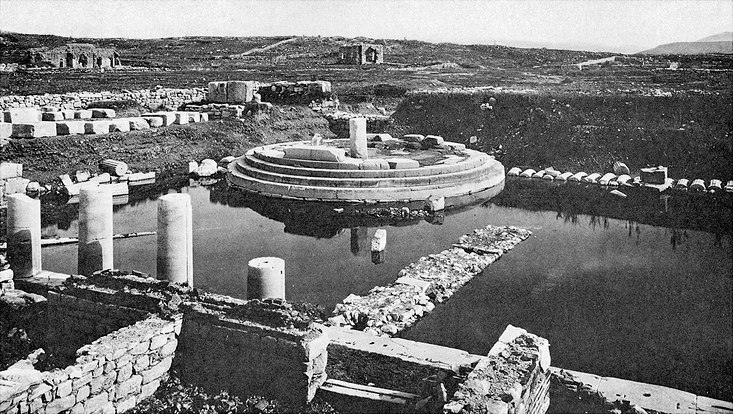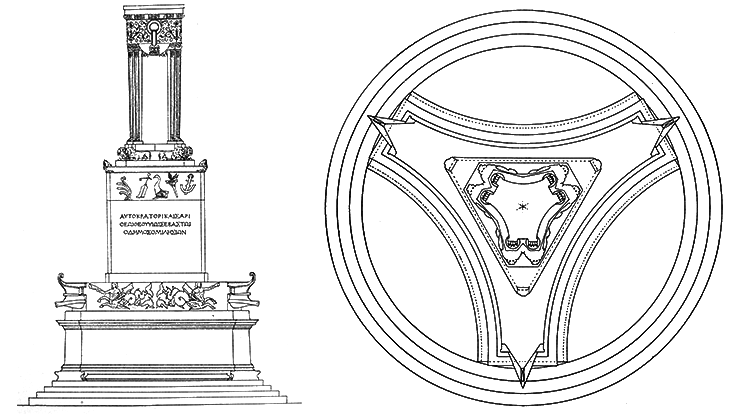Large and Small Harbor Monument
The 2 harbor monuments of Miletus are located to the northwest of the ancient city center, not far from the Lion Harbor, which gave the modern buildings their names. The southernmost of the 2, the Large Harbor Monument, may have been built to celebrate a naval victory in the first century BCE. It originally consisted of a 4-layered, round foundation with a diameter of nearly 12 meters, which is still in place today. In antiquity, it supported a 2.8-meter-tall socle. This socle was shaped like a truncated triangle with recessed edges and had a seating bench around it. A few meters above the socle, there were 3 reliefs all depicting the same maritime motif: 2 symmetrically identical chimera emerging from the vertical central axis, one on each side, with a male human upper body, a horse’s lower body and a fish tail (an ichthyocentaur). A conch has been reconstructed in the extended left and right hand, respectively, of each figure, while an oar blade rested in the crook of the other arm. Under each tail fin, there was a dolphin. Two 3-dimensional ship’s bows (prora) finished the outside of each relief. The further reconstruction of a pedestal above the reliefs and a crowning sacrificial tripod believed to have rested upon crouching lion statues is purely hypothetical, as only very few building elements were found in this area. This may be due to the integration of the Harbor Monument into the new city wall in the third century CE, as the upper section of the building, which would have protruded above the wall, may have been demolished in the process. It is possible that the Large Harbor Monument was originally up to 18 meters tall.
The Small Harbor Monument is located a few meters to the north of the Large Harbor Monument. An inscription reveals that it was donated by a certain C. Grattius. It has been dated to the turn of the eras. Its structure appears to have been inspired by the Large Harbor Monument: The monument’s single-layered foundation, which supports a bench in the same characteristic shape as that of the socle of the Large Harbor Monument, is still visible today. It originally adjoined a wall made from ashlar bricks framed by columns, but its upper end cannot be reconstructed with certainty.
Text: Nadia Cahenzli
References
-
A. von Gerkan, Der Nordmarkt und der Hafen an der Löwenbucht. Mit epigraphischem Beitrag von A. Rehm, Milet 1,6 (Berlin 1922) 55–86.
-
P. Schollmeyer in: R. Bol, Marmorskulpturen aus der römischen Kaiserzeit in Milet. Aufstellungskontext und programmatische Aussage, Milet 5,2 (Berlin 2011).
-
M. Schupp, Caput Ioniae. Zur Untersuchung römischer Hafenfassaden am Beispiel von Milet, in: S. Ladstätter – F. Pirson – T. Schmidts, Häfen und Hafenstädte im östlichen Mittelmeerraum von der Antike bis in byzantinische Zeit. Neue Entdeckungen und aktuelle Forschungsansätze 2 = Harbors and Harbor Cities in the Eastern Mediterranean From Antiquity to the Byzantine Period. Recent Discoveries and Current Approaches 2. Konferenz Istanbul, 30.05.–01.06.2011, Österreichisches Archäologisches Institut Sonderschriften 52 (Istanbul 2014) 661 f.
-
M. Taschner, in: P. Niewöhner (ed.), Milet / Balat. Städtebau und Monumente von Archaischer bis in Türkische Zeit. Ein Führer (Istanbul 2016), 52–55.
-
S. Feuser, Hafenstädte im östlichen Mittelmeerraum vom Hellenismus bis in die römische Kaiserzeit. Städtebau, Funktion und Wahrnehmung, Urbane Spaces 8 (Berlin 2020) 41 f.


